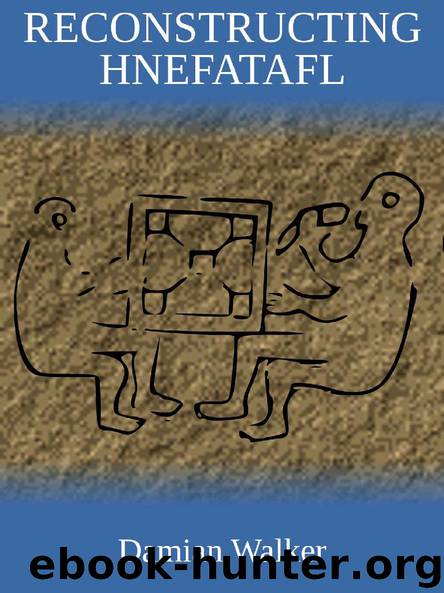Reconstructing Hnefatafl by Damian Walker

Author:Damian Walker
Language: eng
Format: epub, azw3
Tags: Archaelogy, Viking, Social History, Games
Publisher: Cyningstan
Published: 2014-04-24T00:00:00+00:00
Candidate Games
The first game with which this board was identified was that of fox & geese, as suggested by Hencken in 1933. Fox & geese has a number of variants, but all have in common certain recognisable elements. One side consists of a fox or similar prey, whose mission is to kill or evade a number of geese or similar pursuers. A typical example has a fox and thirteen geese arranged on a cross-shaped board now more familiar as peg solitaire. Other games of similar type are played throughout the world, on square and triangular boards, as well as boards of many other shapes. Hencken may have been put in mind of these games by the single marked cell in the centre of the Ballinderry board.
Another family of games distinguished by a special central cell is hnefatafl, as proposed by Murray. Hnefatafl is often classed with hunt games like fox & geese, as a single king in the centre of the board must evade numerous attackers initially arranged around the edge. These attackers have the power of capture, and their aim is to capture the king. Unlike other hunt games, the quarry here has a number of guards to defend him, initially surrounding his central position and usually numbering half as many as the attackers. These defenders have powers of capture equal to that of the attackers. The board is always square, but, as with hunt games of the fox & geese type, its size, and the number of pieces upon it, can vary from one game to another.
Brandub is thought by MacWhite to be a member of the hnefatafl family. Some poetic extracts, quoted in his article, imply that this game was played with a branan, or chief, with four defenders against eight attackers. MacWhite points out that such a game would fit perfectly on the Ballinderry board, and speculates that the men should be laid out in the shape of an orthogonal cross. He suggests that the corner cells could be marked to indicate that men placed here would be safe from capture. Capture in hnefatafl games, it should be remembered, is by surrounding a piece on two opposite sides, something impossible if that piece stands in the corner.
Fithcheall, as proposed by Bell, is somewhat less clear. Bell assumes that fithcheall is another game of the hnefatafl family. Murray, on the other hand, says that fithcheall is a game of equal forces adopted from the Romans (Murray 1952, 35). This agrees with MacWhite's assessment, which is supported by more poetic extracts, for example, "Crimthann Nia Nar's fidchell, a small boy could not lift it with one hand. Half of its men were of yellow gold, the other half of tinned bronze."
The earliest suggestion, a game of the fox & geese type, has little evidence to support it. The central marked cell suggests the possibility of a game with one central important piece. But no evidence of such a game among the tenth-century Irish exists. Of the three board
Download
This site does not store any files on its server. We only index and link to content provided by other sites. Please contact the content providers to delete copyright contents if any and email us, we'll remove relevant links or contents immediately.
| Coloring Books for Grown-Ups | Humor |
| Movies | Performing Arts |
| Pop Culture | Puzzles & Games |
| Radio | Sheet Music & Scores |
| Television | Trivia & Fun Facts |
The Infinite Retina by Robert Scoble Irena Cronin(6164)
Harry Potter and the Cursed Child: The Journey by Harry Potter Theatrical Productions(4440)
The Sports Rules Book by Human Kinetics(4290)
Molly's Game: From Hollywood's Elite to Wall Street's Billionaire Boys Club, My High-Stakes Adventure in the World of Underground Poker by Molly Bloom(3485)
A Knight of the Seven Kingdoms by George R R Martin(3191)
Quidditch Through the Ages by J.K. Rowling(3063)
How To by Randall Munroe(3033)
Flowers For Algernon by Daniel Keyes(3021)
Quidditch Through the Ages by J K Rowling & Kennilworthy Whisp(2930)
Quidditch Through the Ages by Kennilworthy Whisp by J.K. Rowling(2813)
Stacked Decks by The Rotenberg Collection(2811)
Quidditch through the Ages by J. K. Rowling(2768)
Quidditch Through The Ages by J. K. Rowling(2730)
776 Stupidest Things Ever Said by Ross Petras(2695)
Ready Player One: A Novel by Ernest Cline(2650)
What If?: Serious Scientific Answers to Absurd Hypothetical Questions by Randall Munroe(2637)
Beautiful Oblivion by Jamie McGuire(2569)
The Book of Questions: Revised and Updated by Gregory Stock Ph.d(2518)
Champions of Illusion by Susana Martinez-Conde & Stephen Macknik(2414)
